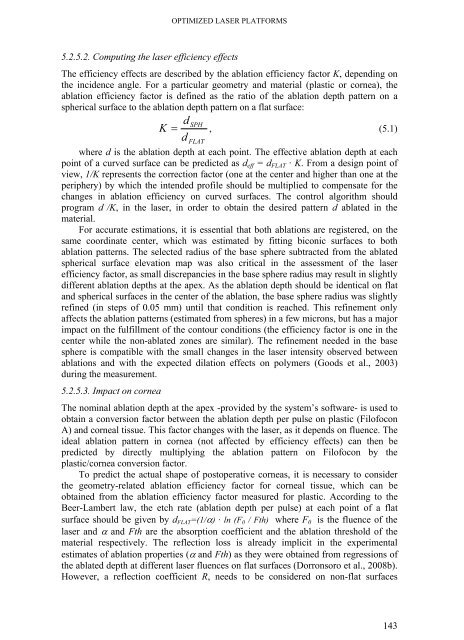Low_resolution_Thesis_CDD_221009_public - Visual Optics and ...
Low_resolution_Thesis_CDD_221009_public - Visual Optics and ...
Low_resolution_Thesis_CDD_221009_public - Visual Optics and ...
Create successful ePaper yourself
Turn your PDF publications into a flip-book with our unique Google optimized e-Paper software.
OPTIMIZED LASER PLATFORMS<br />
5.2.5.2. Computing the laser efficiency effects<br />
The efficiency effects are described by the ablation efficiency factor K, depending on<br />
the incidence angle. For a particular geometry <strong>and</strong> material (plastic or cornea), the<br />
ablation efficiency factor is defined as the ratio of the ablation depth pattern on a<br />
spherical surface to the ablation depth pattern on a flat surface:<br />
d<br />
SPH<br />
K , (5.1)<br />
d<br />
FLAT<br />
where d is the ablation depth at each point. The effective ablation depth at each<br />
point of a curved surface can be predicted as d eff = d FLAT · K. From a design point of<br />
view, 1/K represents the correction factor (one at the center <strong>and</strong> higher than one at the<br />
periphery) by which the intended profile should be multiplied to compensate for the<br />
changes in ablation efficiency on curved surfaces. The control algorithm should<br />
program d/K, in the laser, in order to obtain the desired pattern d ablated in the<br />
material.<br />
For accurate estimations, it is essential that both ablations are registered, on the<br />
same coordinate center, which was estimated by fitting biconic surfaces to both<br />
ablation patterns. The selected radius of the base sphere subtracted from the ablated<br />
spherical surface elevation map was also critical in the assessment of the laser<br />
efficiency factor, as small discrepancies in the base sphere radius may result in slightly<br />
different ablation depths at the apex. As the ablation depth should be identical on flat<br />
<strong>and</strong> spherical surfaces in the center of the ablation, the base sphere radius was slightly<br />
refined (in steps of 0.05 mm) until that condition is reached. This refinement only<br />
affects the ablation patterns (estimated from spheres) in a few microns, but has a major<br />
impact on the fulfillment of the contour conditions (the efficiency factor is one in the<br />
center while the non-ablated zones are similar). The refinement needed in the base<br />
sphere is compatible with the small changes in the laser intensity observed between<br />
ablations <strong>and</strong> with the expected dilation effects on polymers (Goods et al., 2003)<br />
during the measurement.<br />
5.2.5.3. Impact on cornea<br />
The nominal ablation depth at the apex -provided by the system’s software- is used to<br />
obtain a conversion factor between the ablation depth per pulse on plastic (Filofocon<br />
A) <strong>and</strong> corneal tissue. This factor changes with the laser, as it depends on fluence. The<br />
ideal ablation pattern in cornea (not affected by efficiency effects) can then be<br />
predicted by directly multiplying the ablation pattern on Filofocon by the<br />
plastic/cornea conversion factor.<br />
To predict the actual shape of postoperative corneas, it is necessary to consider<br />
the geometry-related ablation efficiency factor for corneal tissue, which can be<br />
obtained from the ablation efficiency factor measured for plastic. According to the<br />
Beer-Lambert law, the etch rate (ablation depth per pulse) at each point of a flat<br />
surface should be given by d FLAT =(1/) · ln (F 0 / Fth) where F 0 is the fluence of the<br />
laser <strong>and</strong> <strong>and</strong> Fth are the absorption coefficient <strong>and</strong> the ablation threshold of the<br />
material respectively. The reflection loss is already implicit in the experimental<br />
estimates of ablation properties ( <strong>and</strong> Fth) as they were obtained from regressions of<br />
the ablated depth at different laser fluences on flat surfaces (Dorronsoro et al., 2008b).<br />
However, a reflection coefficient R, needs to be considered on non-flat surfaces<br />
143











